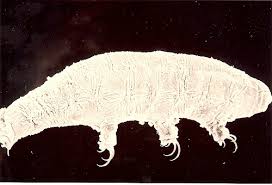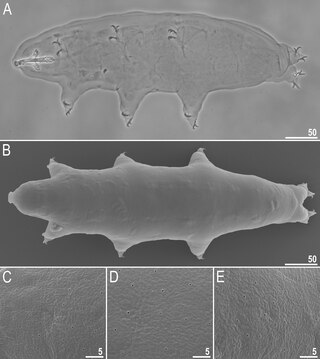
Tardigrades, known colloquially as water bears or moss piglets, are a phylum of eight-legged segmented micro-animals. They were first described by the German zoologist Johann August Ephraim Goeze in 1773, who called them Kleiner Wasserbär'little water bear'. In 1776, the Italian biologist Lazzaro Spallanzani named them Tardigrada, which means 'slow walker'.

Echiniscus testudo is a cosmopolitan species of tardigrade.

Hypsibius is a genus of tardigrades in the class Eutardigrada.
Diphascon is a genus of water bear or moss piglet, a tardigrade in the class Eutardigrada.

Doryphoribius is a genus of water bear or moss piglet, a tardigrade in the class Eutardigrada.

Ramazzottius is a genus of water bear or moss piglet, a tardigrade in the class Eutardigrada, named after the Italian zoologist Giuseppe Ramazzotti.

Itaquascon is a genus of tardigrade in the class Eutardigrada.

Isohypsibius is a genus of water bear or moss piglet, a tardigrade in the class Eutardigrada. The length of an isohypsibius tardigrade ranges from 0.1 millimeters to 1.5 millimeters. In addition to eating algae and plant cells, tardigrades also consume insect larvae and even other tardigrades. They live in a lot of places, like damp wooded areas with moss, lichens, leaf litter, and dirt. These animals can also be found in natural lakes and ponds.

Milnesium is a genus of tardigrades. It is rather common, being found in a wide variety of habitats across the world. It has a fossil record extending back to the Cretaceous, the oldest species found so far is known from Turonian stage deposits on the east coast of the United States. Milnesiums are one of the most desiccation and radiation-resistant invertebrates on Earth because of their unique ability to transform into a "tun" state and utilize intrinsically disordered proteins when experiencing extreme environments.

Milnesiidae is a family of tardigrades of the class Eutardigrada. It is the sole family in the order Apochela.
Pseudechiniscus is a genus of tardigrades in the family Echiniscidae. The genus was named and described by Gustav Thulin in 1911.

Bryodelphax is a genus of tardigrades in the family Echiniscidae. The genus was first described by Gustav Thulin in 1928.
Macrobiotidae is a family of tardigrade. As of 2023, it consists of the following genera:

Macrobiotus is a genus of tardigrade consisting of about 100 species.
Calcarobiotus is a genus of tardigrades belonging to the family Macrobiotidae.
Mesobiotus is a genus of tardigrades belonging to the family Macrobiotidae.











